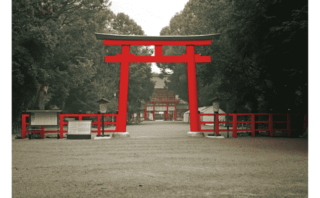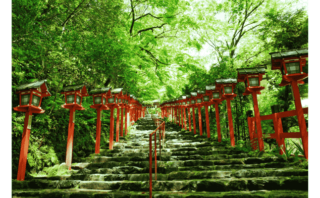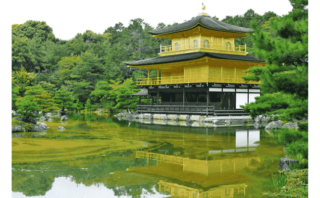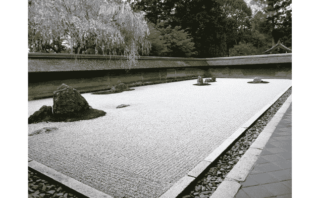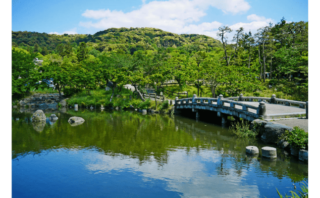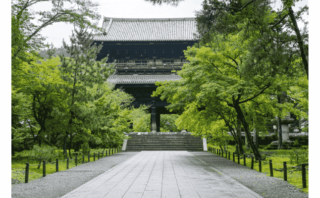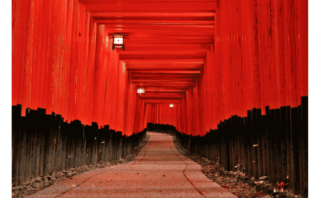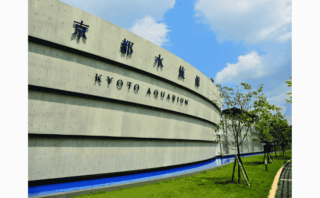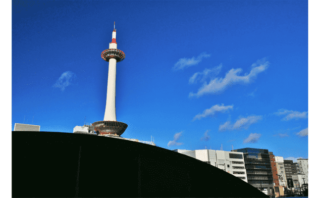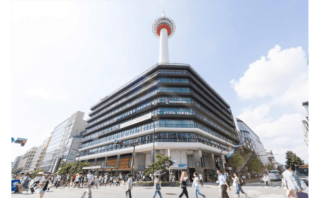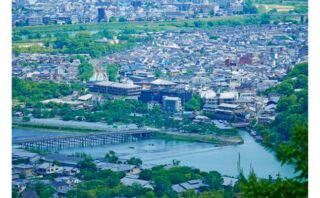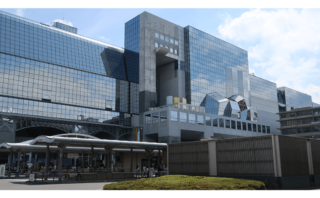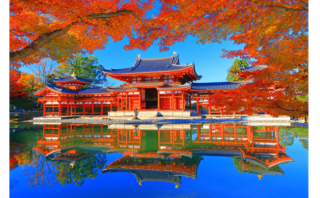Kyoto, a city with over 1,200 years of history, is filled with stunning sights, from historic buildings to breathtaking natural scenery.
While Kyoto is one of Japan’s most famous tourist destinations, it’s also the perfect place for a romantic date. You can discover fascinating history together, be captivated by beautiful views, and create lasting memories.
Explore Japan’s culture and history in unique ways, and share meaningful experiences with your partner.
Each area of Kyoto offers a different atmosphere, bringing out new sides of both the city and your relationship.
In this article, we’ve carefully selected the best date spots in Kyoto, divided by area, to help deepen your bond while enjoying this enchanting city.
- Recommended Date Spots in Northern Kyoto (Eizan Railway, Demachiyanagi, and Nijo)
- Recommended Date Spots in Northwest Kyoto (Daimonji Mountain and Kinugasa Area)
- Recommended Date Spot in Western Kyoto(Arashiyama, Katsura, and Uzumasa)
- Recommended Date Spots in Eastern Kyoto (Higashiyama & Gion)
- Recommended Date Spots in Southern Kyoto (Kyoto Station and Fushimi)
- The Charm of a Kimono Date in Kyoto and Tips to Enjoy It
Recommended Date Spots in Northern Kyoto (Eizan Railway, Demachiyanagi, and Nijo)

This area covers Demachiyanagi Station, the last stop on the Keihan Railway, the Eizan Railway line, and the Nijo Castle area.
It’s home to historic landmarks like Shimogamo Shrine, Honman-ji Temple, and Nijo Castle. Being slightly removed from the busy city center, it has a calm and relaxed atmosphere.
If you’re looking to take your time exploring shrines and temples, this is the perfect spot. You can enjoy a peaceful day surrounded by Japanese culture and nature.

One of the highlights of this area is the seasonal beauty of the Kamo River. Don’t miss the famous stepping stones across the river—perfect for a bit of fun and adventure.
If you’re dressed for comfort, why not try crossing the stepping stones together? It might even lead to a sweet moment, like him holding your hand when things get a little tricky!
This activity lets you enjoy nature while getting closer to each other. It’s a simple yet memorable experience, so be sure to give it a try!
1. Shimogamo Shrine

Shimogamo Shrine, a UNESCO World Heritage Site, is known for its stunning design and harmonious colors.
The shrine is dedicated to the deity of victory, making it a great place to visit when starting something new. It also has a matchmaking shrine on the grounds, making it a popular spot for love and relationships.
Why not wish for happiness together and deepen your bond as a couple?

Shimogamo Shrine is not just about love—it’s also known as a place to pray for victory, including overcoming rivals in romance. With blessings for both love and success, you can strengthen your relationship without worrying about competition.
Shimogamo Shrine (Kamo Mioya Shrine)
- Address: 59 Shimogamo Izumigawa-cho, Sakyo-ku, Kyoto, Japan
- Map: [Google Maps Link]
- Access:
- 25 minutes by bus from Kyoto Station
- 12 minutes on foot from Demachiyanagi Station
- Phone Number: +81 75-781-0010
- Visiting Hours:
- Summer: 5:30 AM – 6:00 PM
- Winter: 6:30 AM – 5:00 PM
- Special Areas (Oimaden and Chomei-an Hermitage): 10:00 AM – 4:00 PM
- Official Website: Shimogamo Shrine
2. Kifune Shrine
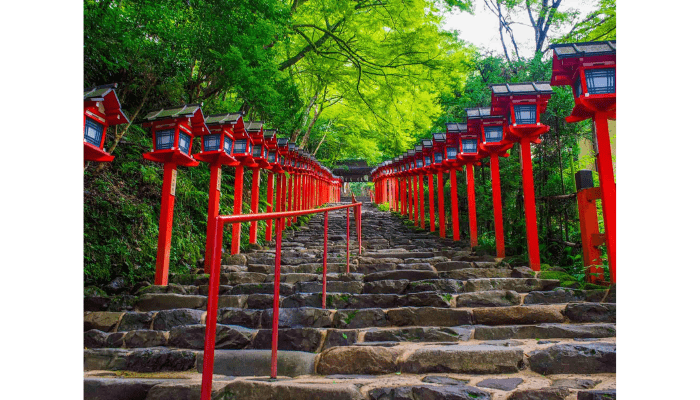
Kifune Shrine is famous for its iconic rows of lanterns and transforms beautifully with each season.
In autumn, the vibrant red leaves create a breathtaking view, while in winter, the area gets more snow than the city, making the sight of snow-covered lanterns truly magical.
The atmosphere changes between day and night, and visiting at different times or seasons allows you to experience a variety of stunning landscapes.
Wearing a kimono and taking photos here adds an extra layer of elegance and charm to your visit.

Kifune Shrine is known for granting wishes of all kinds, but it is especially popular for love and romantic blessings. Inside the shrine grounds is the Naka-no-Miya, also known as Yui-no-Yashiro, which is believed to have extraordinary powers for matchmaking.
This reputation dates back to the Heian period when the poet Izumi Shikibu prayed here to mend her relationship with her husband, and her wish was miraculously fulfilled. Because of this, Kifune Shrine has long been a destination for those seeking love.
The more you pray for love, the stronger the blessings are believed to become. Take the opportunity to soak in the shrine’s centuries-old power to bring people closer together.
Kifune Shrine (Kyoto)
- Address: 180 Kurama Kibune-cho, Sakyo-ku, Kyoto, Japan
- Map: [Google Maps Link]
- Access:
- About 20 minutes by bus from Kyoto International Conference Center Station
- 30 minutes on foot from Kibuneguchi Station on the Eizan Railway Kurama Line
- After arriving at Kibuneguchi Station, take Kyoto Bus No. 33 to Kibune Station (a short walk from there)
- Phone Number: +81 75-741-2016
- Visiting Hours:
- Main Shrine Hours:
- 6:00 AM – 8:00 PM (May 1 – Nov 30)
- 6:00 AM – 6:00 PM (Dec 1 – Apr 30)
- Blessing Counter Hours: 9:00 AM – 5:00 PM
- (For water fortune slips, charms, and temple stamps)
- Special Light-Up: Until 8:30 PM during the “Kifune Autumn Lantern Festival”
- Main Shrine Hours:
- Fees: Free entry (Temple stamps cost ¥300)
- Official Website: Kifune Shrine Official Site
3. Shisendo

Shisendo is the former mountain retreat of Ishikawa Jozan, a scholar and poet from the early Edo period. Today, it is a nationally designated historic site.
From the building, you can enjoy a dynamic view of the garden, which showcases stunning scenery throughout the seasons. It’s like looking at a breathtaking panoramic photograph!
In autumn, the garden becomes especially vibrant, with bright red maple leaves creating a striking contrast against the lush green moss—a truly unforgettable sight.

But there’s more to Shisendo than just its scenic beauty. Did you know it is the birthplace of the shishi-odoshi, or “deer scarer”?
The iconic bamboo device, which fills with water, tips over, and makes a satisfying “clack” sound, was invented here. Many visitors might recall being mesmerized by watching it in traditional Japanese gardens.
When you visit Shisendo, don’t just focus on the view—pay attention to the sounds as well. Listen carefully to the rhythmic “clack” of the shishi-odoshi, and embrace the tranquil silence that surrounds you.
Even without words, you may find yourself sharing the same peaceful emotions as those around you, creating a special sense of connection.
Shisendo Jozanji Temple
- Address: 27 Ichijoji Monguchi-cho, Sakyo-ku, Kyoto, Japan
- Map: [Google Maps Link]
- Access: From Ichijoji Shimoimamachi Bus Stop, walk 7 minutes east
- Closed: May 23 (for the Jozan Memorial Day)
- Phone Number: +81 75-781-2954
- Hours: 9:00 AM – 5:00 PM (Last admission: 4:45 PM)
- Admission Fee:
- Adults: ¥500
- High school students: ¥400
- Elementary & middle school students: ¥200
- Official Website: Shisendo Official Site
4. Kurama Onsen
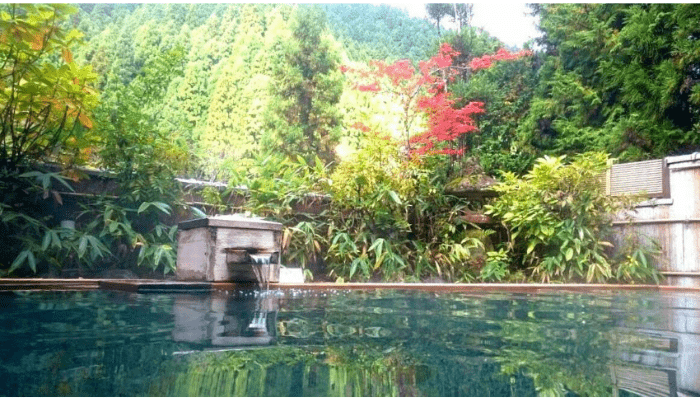
How about a relaxing hot spring date in Kyoto?
Located about an hour from Kyoto’s city center, Kurama Onsen is a hidden gem in the mountains where you can enjoy a day trip to the hot springs without a reservation. Conveniently, a free shuttle bus runs from Kurama Station on the Eizan Railway, timed to match train arrivals.
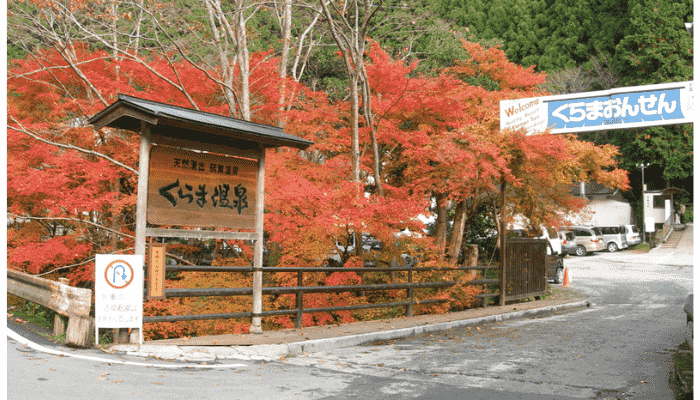
The Day Trip Course (¥2,500, including bathing tax) offers access to a large indoor bath (featuring a cold bath, bubble bath, and sauna) and an outdoor bath. It also includes yukata rental, towels, and access to a spacious rest area. You can take breaks, enjoy meals (for an additional fee), and soak in the baths as many times as you like.
For those with limited time, the Outdoor Bath Course (¥1,000) is a great option, allowing one-time use of the open-air bath. However, please note that towels are not included, so bring your own or rent them for a fee.
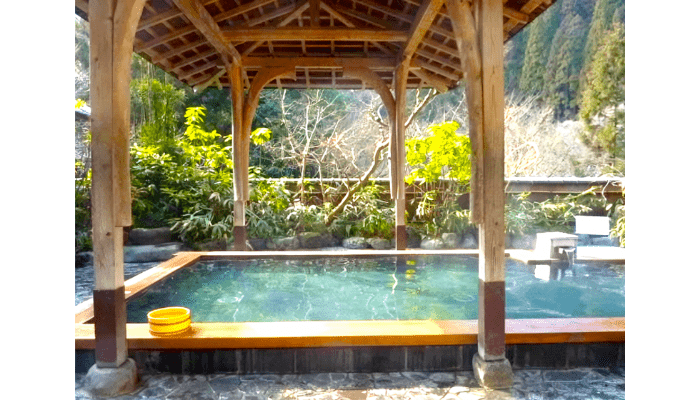
The hot spring water at Kurama Onsen is a natural sulfur hydrogen spring, rich in minerals. It’s said to help with nerve pain, rheumatism, diabetes, back pain, and even skin beauty. With such a range of benefits, you’ll leave feeling refreshed and rejuvenated.
While Kurama’s nature is beautiful year-round, winter is particularly special. Imagine soaking in the outdoor bath, surrounded by snow-covered Kitayama cedar trees. Pair that with a warm local meal like duck hot pot or local chicken hot pot, and you’ve got the perfect cozy experience.
For a unique and tranquil getaway, Kurama Onsen offers a romantic setting that’s sure to bring you closer together.
Kurama Onsen
- Address: 520 Kuramahonmachi, Sakyo-ku, Kyoto, Japan
- Map: [Google Maps Link]
- Access: 10-minute walk from Kurama Station on the Eizan Railway or a 3-minute ride on the free shuttle bus
- Closed: Open year-round
- Phone Number: +81 75-741-2131
- Hours: 10:30 AM – 9:00 PM
- Fees: Varies by plan; check the official website for details
- Official Website: Kurama Onsen
Recommended shop in Northern Kyoto: Demachi Futaba

If you’re exploring northern Kyoto, don’t miss Demachi Futaba, a famous wagashi (Japanese confectionery) shop located near Demachiyanagi Station.
Their signature daifuku is a masterpiece! The soft, sticky mochi pairs perfectly with the subtly salted beans and the smooth, delicate sweetness of the red bean paste. It’s a harmonious combination that melts in your mouth.
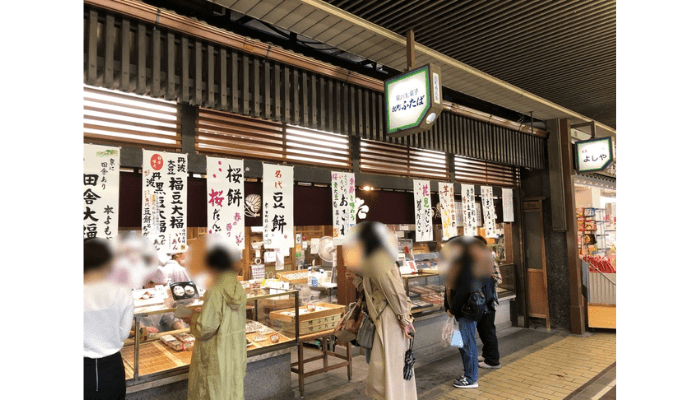
It’s no wonder you’ll often see a long line outside the shop, as these daifuku are highly sought after and can be hard to get. However, if you visit right after the shop opens or during less busy hours, you’ll have a better chance of avoiding the crowds.
Why not take this opportunity to try Demachi Futaba’s daifuku? Grab one and enjoy it together by the nearby Kamo River—a perfect way to savor this Kyoto specialty in a scenic setting.
Demachi Futaba
- Address: 236 Seiryu-cho, Kamigyo-ku, Kyoto, Japan
- Map: [Google Maps Link]
- Access: 7-minute walk from Exit 5 of Demachiyanagi Station (Keihan Main Line)
- Phone Number: +81 75-231-1658
- Hours: 8:30 AM – 5:30 PM
- Closed: Tuesdays and the 4th Wednesday of each month
- (closed the following day if it’s a holiday)
- extended closures during the New Year holiday
- Note: Takeout only
Recommended Date Spots in Northwest Kyoto (Daimonji Mountain and Kinugasa Area)

Northwest Kyoto is home to some of the city’s most iconic landmarks, including the glittering Golden Pavilion (Kinkaku-ji), Ryoan-ji Temple, and Kitano Tenmangu Shrine.
Unlike Kyoto’s northern area, which is known for its simple, wabi-sabi-inspired architecture, this region features more vibrant and ornate structures, offering a unique and colorful charm.
Here, you can enjoy the harmony and striking contrast between nature and the architecture, creating a truly picturesque experience.
If it’s your first time visiting Kyoto or you want to feel the essence of the city, this area is the perfect starting point for your journey!
1. Kinkaku-ji

When people think of Kyoto, Kinkaku-ji (Golden Pavilion) often comes to mind. However, its official name is actually Rokuon-ji Temple.
The dazzling golden exterior of Kinkaku-ji continues to captivate visitors, retaining its brilliance and elegance throughout the ages.
Built in 1397 during the Muromachi period, this temple was originally constructed by Ashikaga Yoshimitsu, the third shogun of the Ashikaga shogunate. It is said that the gold leaf covering the pavilion symbolized the immense wealth and power of the shogunate at the time.
Unfortunately, the original structure was completely destroyed in a fire in 1950. What you see today is a faithful reconstruction, showcasing the pavilion’s original beauty.

The charm of Kinkaku-ji lies not only in the golden pavilion itself but also in the surrounding scenery. One of the most iconic views is the reflection of the pavilion on the pond’s surface. On calm days, the still water acts like a mirror, perfectly reflecting the structure.
Each season offers a unique backdrop for Kinkaku-ji:
- Late Spring (May–June): Purple irises (kakitsubata) bloom around the pond, adding a splash of color to the golden pavilion.
- Winter: The pavilion looks stunning when covered in a layer of snow, creating a magical, serene atmosphere.
Visiting Kinkaku-ji during different times of the year allows you to enjoy its changing beauty.
Why not capture a photo of Kinkaku-ji and share a conversation about its rich history as part of your Kyoto memories?
Kinkaku-ji (Golden Pavilion)
- Address: 1 Kinkakuji-cho, Kita-ku, Kyoto, Japan
- Map: Google Maps Link
- Access: Take the Kyoto City Bus to the Kinkakuji-michi bus stop.
- Phone: 075-461-0013
- Open Year-Round
- Hours: 9:00 AM – 5:00 PM
- Admission Fee:
- Adults (high school students and older): 500 yen (effective April 1, 2023)
- Elementary/Middle school students: 300 yen
- Official Website: Kinkaku-ji Website
2. Ryoan-ji
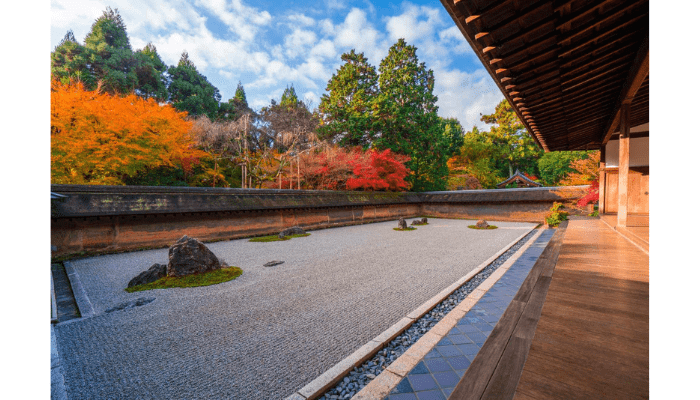
Ryoan-ji Temple is renowned for its beautiful Zen rock garden.
At first glance, the garden appears simple—a collection of stones surrounded by meticulously raked white gravel. However, the garden’s design is carefully calculated, and many visitors find themselves captivated by its tranquil beauty, losing track of time as they gaze upon it.

While spring brings cherry blossoms and autumn offers colorful leaves, the contrast between the garden’s simplicity and the lush green surroundings from early summer to fall is equally breathtaking.
Start by chatting with your companion while enjoying the view of the rock garden. Once the conversation naturally slows, try sitting quietly and sharing the unchanging beauty of the scene together. You might find your heart feeling lighter and a renewed appreciation for the person beside you.
Ryoan-ji Temple
- Address: 13 Ryoanji Goryonoshita-cho, Ukyo-ku, Kyoto, Japan
- Map: Google Maps Link
- Access:
- 7-minute walk from Ryoanji Station (Keifuku Electric Railroad)
- 7-minute walk from Ritsumeikan Daigaku-mae bus stop (Kyoto City Bus Route 50 from Kyoto Station)
- Phone: 075-463-2216
- Open Year-Round
- Hours:
- March–November: 8:00 AM – 5:00 PM
- December–February: 8:30 AM – 4:30 PM
- Goshuin (Temple Stamp) Hours: 9:00 AM – 4:00 PM
- Admission Fee:
- Adults: 600 yen (effective April 1, 2023)
- High school students: 500 yen
- Elementary/Middle school students: 300 yen
- Official Website: Ryoan-ji Website
3. Genko-an Temple

Genko-an Temple, built in 1346, was originally the retirement home of Tetsuo Giko, a monk from the Rinzai sect of Daitoku-ji Temple.
This temple is famous for its two symbolic windows:
- The Circular Window of Enlightenment represents Zen and harmony, symbolizing the pure and unbiased state of enlightenment.
- The Square Window of Delusion represents the struggles of human life, illustrating the “Four Sufferings” of birth, aging, illness, and death, as taught by Buddha.
Visitors are encouraged to first reflect on their own doubts and challenges in front of the Square Window. Then, move to the Circular Window to embrace your true self and find peace within. This process is believed to renew your spirit and help you reconnect with what truly matters in life.
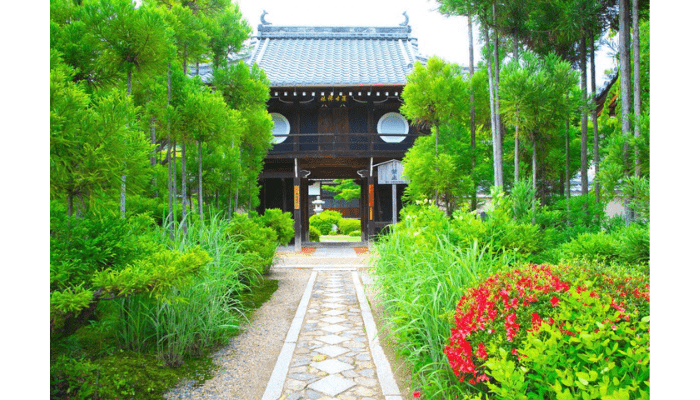
Sitting silently in the temple’s tranquil atmosphere allows you to cleanse your heart and mind. Sharing this serene moment with someone special can deepen your bond and help you appreciate the happiness of being together.
Genko-an is also popular for its ever-changing seasonal views framed by the two windows. Whether it’s the vibrant greens of summer, the fiery reds of autumn, or the serene snowscapes of winter, each visit offers a fresh perspective. Many visitors return throughout the year to enjoy these transformations.
Genko-an Temple
- Address: 47 Kita Takagamine-cho, Kita-ku, Kyoto, Japan
- Map: Google Maps Link
- Access: A short walk from the “Genko-an Mae” bus stop (Kyoto City Bus)
- Phone: 075-492-1858
- Open Year-Round (closed occasionally for temple events)
- Hours: 9:30 AM – 5:00 PM
- Admission Fee:
- Adults (middle school and above): 400 yen
- Autumn foliage season: Adults 500 yen, Elementary school students 200 yen
- Official Website: Genko-an Temple Website
Recommended shop in Northwest Kyoto: Awamochidokoro Sawaya
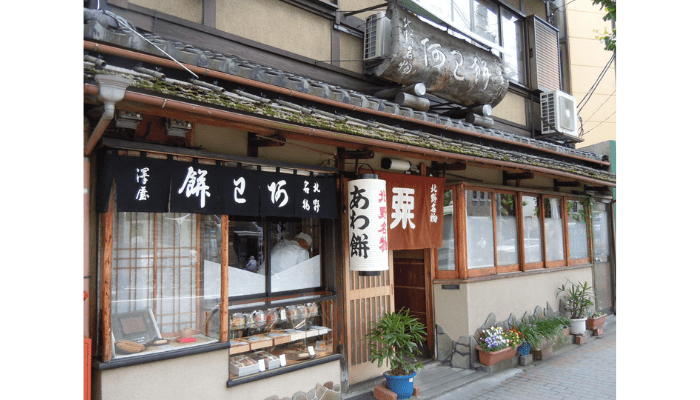
If you’re visiting northwest Kyoto, don’t miss Awamochidokoro Sawaya, a traditional Japanese tea house where you can enjoy freshly pounded awa mochi (millet rice cakes).
The freshly made mochi here is incredibly soft, smooth, and delightfully stretchy. The subtle pop of millet grains adds a unique texture that will leave you craving more!
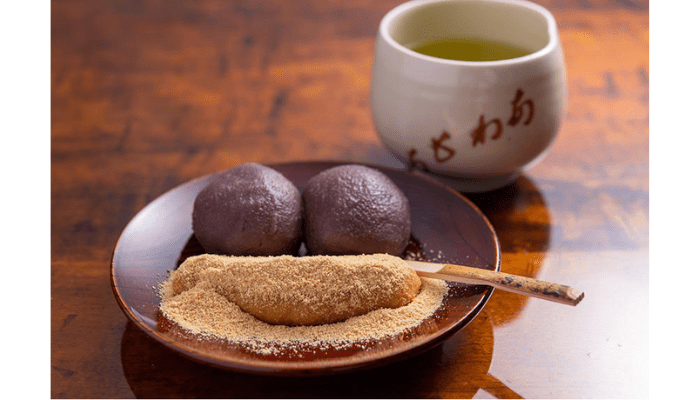
You can choose from two toppings:
- Kinako (roasted soybean flour): Sweet but refined, with a gentle flavor that perfectly complements the mochi. The sweetness melts away smoothly in your mouth.
- Anko (red bean paste): Less sweet but incredibly smooth, with a rich azuki bean flavor that dissolves effortlessly when paired with the mochi.
For the ultimate experience, try both toppings to enjoy the perfect combination of mochi, kinako, and anko.
Awamochidokoro Sawaya
- Address: 838-7 Kamiyagawa-cho, Kitano Tenmangu-mae, Kamigyo-ku, Kyoto, Japan
- Map: Google Maps Link
- Access:
- 5-minute walk from Kitano Hakubaicho Station (Keifuku Kitano Line)
- 1-minute walk from “Kitano Tenmangu-mae” bus stop (Kyoto City Bus)
- Closed: Thursdays and the 26th of each month
- Phone: 075-461-4517
- Hours: 9:00 AM – 5:00 PM (closes earlier if sold out)
- Price Range: ~999 yen
Recommended Date Spot in Western Kyoto(Arashiyama, Katsura, and Uzumasa)

Arashiyama is a scenic area in western Kyoto, originally referring to the western bank of the Katsura River. Nowadays, it’s commonly used to describe the area around the iconic Togetsukyo Bridge.
This area is famous for its stunning cherry blossoms in spring and vibrant autumn foliage, attracting visitors from all over Japan during these seasons. Remarkably, the breathtaking scenery you see today has remained largely unchanged for over 1,000 years since the Heian period.
One of Arashiyama’s charms is its abundance of nature-based attractions. From the picturesque Togetsukyo Bridge to the serene Bamboo Grove and the historic Tenryu-ji Temple, the area showcases the natural beauty of Kyoto.
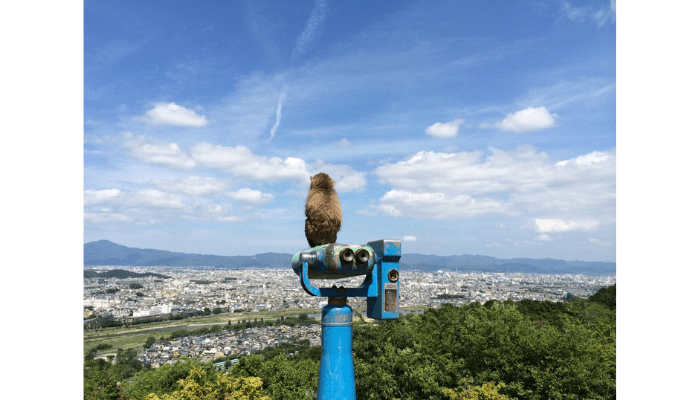
Imagine the same views people enjoyed over a thousand years ago as you stroll through Arashiyama. Take your time to discover hidden traces of history that others might overlook.
Let your mind wander to the ancient past while soaking in the beauty of the natural surroundings. It’s a perfect spot for a romantic date or a peaceful day out.
1. Bamboo Grove Path

Located in Sagano, just north of Togetsukyo Bridge, the Bamboo Grove is a breathtaking sight that will leave you speechless the moment you see it. Tall bamboo stalks rise on both sides of the pathway, creating a magical, tunnel-like route.
Take a leisurely stroll through the grove and enjoy the unique atmosphere: the fresh scent of bamboo, the cool air, and the gentle rustling sound of the leaves swaying in the wind.
While this is a popular tourist spot and can get crowded, visiting during off-peak times allows for a more relaxed experience.
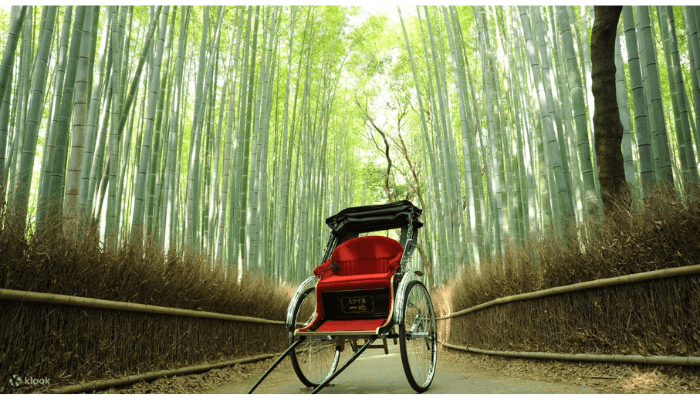
If time and budget allow, consider exploring the Bamboo Grove on a rickshaw ride. Not only does it add a touch of elegance to your visit, but it also offers an opportunity to hear fascinating stories and historical insights from your rickshaw guide.
For couples in traditional kimono, the grove makes for a stunning backdrop—perfect for memorable photos. Passersby might even stop to capture the charming scene!

As you ride through the grove, listening to its history and legends, you’ll feel as though you’ve traveled back in time. The unique combination of beauty and storytelling will make your visit unforgettable.
After your ride, the shared experience will give you plenty to talk about, ensuring your adventure doesn’t end once you leave the grove.
Bamboo Grove Path
- Address: Arashiyama, Ukyo Ward, Kyoto City, Kyoto Prefecture
- Map: Google Maps
- Access:
- 10-minute walk from Randen Arashiyama Station or JR Saga-Arashiyama Station
- 15-minute walk from Hankyu Arashiyama Station
- Phone: 075-861-0012 (Arashiyama Preservation Society)
- Closed: Open year-round
- Hours: Free to explore anytime
- Admission Fee: Free
2. Tenryu-ji Temple

Located near Togetsukyo Bridge and the famous Bamboo Grove, Tenryu-ji Temple is a historic gem with a fascinating story of resilience.
Tenryu-ji has faced numerous natural disasters and fires over the centuries. Despite these challenges, it has been rebuilt time and again, standing as a symbol of perseverance.
Originally, the temple grounds were ten times larger than what you see today. During the Meiji era, much of the land had to be relinquished, which explains its relatively small size compared to other temples.
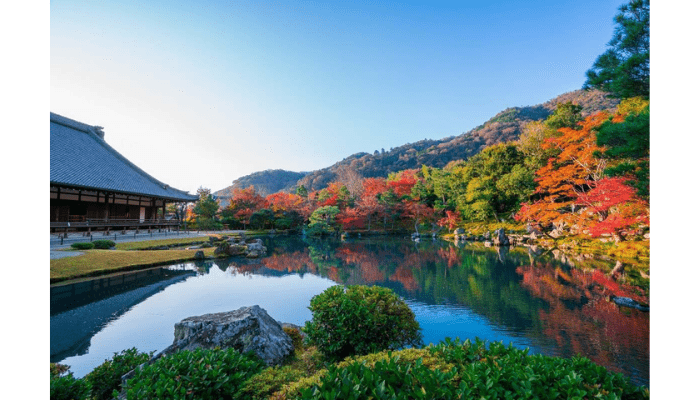
Tenryu-ji is known for its simple and nature-inspired design. The temple grounds allow visitors to enjoy the beauty of seasonal plants and trees up close, creating a tranquil atmosphere that refreshes the spirit.
Unlike some of Kyoto’s more famous temples, Tenryu-ji tends to be less crowded, making it a perfect spot for a peaceful stroll.
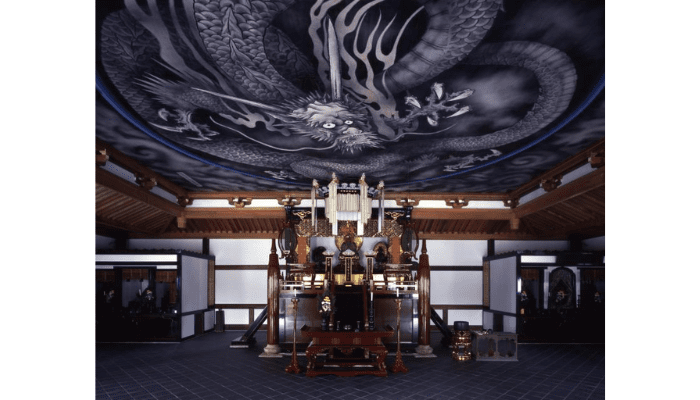
Having survived countless challenges, Tenryu-ji carries a message of overcoming adversity. Visiting this temple may inspire you with the strength to face your own challenges.
For couples, buying matching amulets is a wonderful way to share in the temple’s positive energy and blessings.
Tenryu-ji
- Address: 68 Sagatenryuji Susukinobaba-cho, Ukyo Ward, Kyoto City, Kyoto Prefecture
- Map: Google Maps
- Access:
- Right outside Randen Arashiyama Station
- 13-minute walk from JR Saga-Arashiyama Station
- 15-minute walk from Hankyu Arashiyama Station
- Phone: 075-881-1235
- Closed: Open year-round
- Hours: 8:30 AM – 5:00 PM (last admission at 4:50 PM)
- Admission Fees
- Gardens (Sogenchi Pond & Hyakkaen Garden):
- Adults (high school and above): ¥500
- Children (elementary and middle school): ¥300
- Free for preschoolers
- ¥100 discount for visitors with a disability certificate and one caregiver
- Temple Buildings (Main Hall, Drawing Room, Treasure Hall):
- Additional ¥300 to the garden fee
- (open 8:30 AM – 4:45 PM, last admission 4:30 PM)
- Hatto Hall’s “Cloud Dragon” Painting (Special Viewing):
- ¥500
- (separate from the above fees; open 9:00 AM – 4:45 PM, last admission 4:30 PM)
- Gardens (Sogenchi Pond & Hyakkaen Garden):
- Official Website: Tenryu-ji Temple
3. Suzumushi Temple (Kegon-ji)

While its official name is Myotokuzan Kegon-ji, this temple is commonly known as Suzumushi Temple because you can hear the soothing chirping of suzumushi (bell crickets) throughout the year.
Suzumushi Temple was founded in 1723 by Hōtan Shōnin, a monk of the Kegon school of Buddhism. Today, it belongs to the Rinzai Zen sect.
Take a moment to enjoy the rare and beautiful sound of suzumushi, a treat that has become less common in modern times.

One of the temple’s most famous features is its Happiness Jizo (Shiawase Jizo-san), a unique statue of Jizo Bodhisattva. Unlike most Buddhist statues, which are barefoot, this Jizo wears straw sandals.
The sandals symbolize the Jizo’s ability to walk to your location and grant your wish. It is said that the Happiness Jizo will fulfill one wish per person, making each prayer feel even more special.
When you visit, take your time to pray sincerely for your greatest wish. Who knows? The Jizo might just bring it directly to you!
Suzumushi Temple (Kegon-ji)
- Address: 31 Matsumuro Jike-cho, Nishikyo Ward, Kyoto City, Kyoto Prefecture
- Map: Google Maps
- Access: 10-minute walk from Hankyu Matsuo Taisha Station
- Phone: 075-381-3830
- Hours: 9:00 AM – 5:00 PM (last entry at 4:30 PM)
- Admission Fees:
- Adults: ¥500
- Children (4 years old to junior high school): ¥300 (includes tea and sweets)
- Official Website: Suzumushi Temple
4. Kyoto Arashiyama Orgel Museum

In the bustling Arashiyama area, there’s a hidden gem where you can take a peaceful break from sightseeing: the Kyoto Arashiyama Orgel Museum.
The museum houses a fascinating collection of antique music boxes, including the world’s oldest music box, made in Switzerland in 1796. Most of the items on display are over 100 years old, with a total collection of around 2,000 pieces. At any given time, about 150 music boxes are exhibited, and the displays are rotated regularly.
During your visit, you can join a 30-minute guided presentation by staff, where you’ll hear the delicate sounds of various music boxes and enjoy demonstrations of automata—intricately designed mechanical dolls.

The museum also features a music box shop showcasing pieces from REUGE, a famous Swiss brand with over 150 years of history. You’ll also find Japanese-made music boxes, jewelry boxes, dolls, CDs, and even the option to create a custom music box. Choose your favorite melody and design to craft a truly unique keepsake.
The museum’s Orgel Café is a serene space decorated with stunning stained glass. Here, you can enjoy light meals like pasta and curry, as well as desserts, all while listening to the soothing melodies of antique music boxes.
For couples, the special discount ticket allows two adults to enter for just ¥1,500, instead of the regular ¥1,000 per person.
Kyoto Arashiyama Orgel Museum
- Address: 1-38 Sagatenryuji Tateishi-cho, Ukyo Ward, Kyoto City, Kyoto Prefecture
- Map: Google Maps
- Access: 5-minute walk west from JR Saga-Arashiyama Station
- Phone: 075-865-1020
- Closed: Irregular holidays (Check the official website or call ahead)
- Hours:
- 10:00 AM – 6:00 PM (January–February: Until 5:00 PM)
- Admission Fees:
- Adults: ¥1,000
- University Students: ¥700
- High School Students: ¥600
- Couples: ¥1,500 for two adults
- Official Website: Kyoto Arashiyama Orgel Museum
5. Kimono Forest
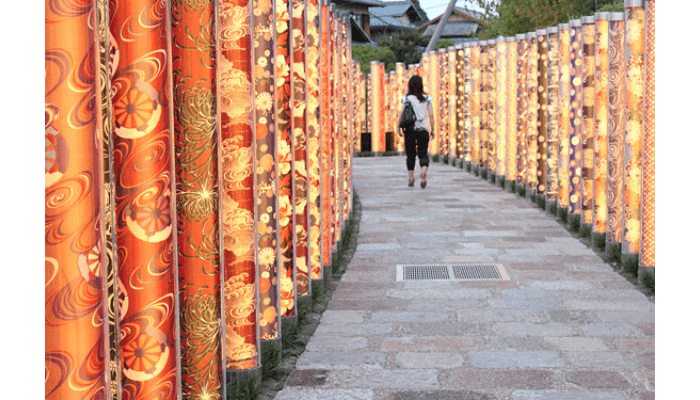
The Randen (short for “Arashiyama Electric Railway”) is a nostalgic streetcar line operated by Keifuku Electric Railway. For decades, it has been a convenient and beloved mode of transport for locals.
In 2013, Arashiyama Station, the gateway to this popular area, underwent a stylish renovation, transforming into a vibrant space called Hannari Hokkori Square.
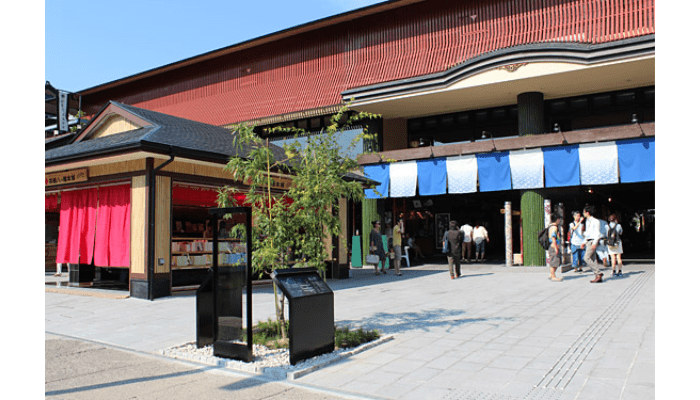
With no ticket gates, the station is now open for everyone to explore. The square features a foot bath, souvenir shops, boutiques, cafes, and restaurants, making it a perfect spot for lunch or gift shopping during your visit to Arashiyama.
The highlight of Hannari Hokkori Square is the stunning Kimono Forest, a mesmerizing art installation.
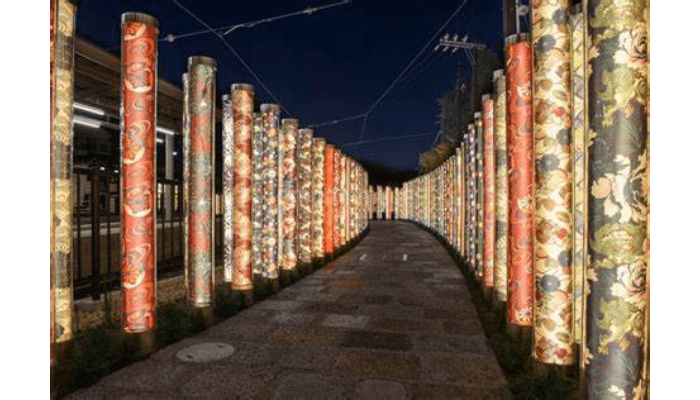
The Kimono Forest consists of 600 cylindrical poles, each standing 2 meters tall and wrapped in 32 unique patterns of traditional Yuzen kimono fabric. During the day, the intricate designs are eye-catching, but at night, the magic truly begins. The poles light up with soft LED illumination, creating a dreamlike atmosphere as the beautiful kimono patterns glow gently in the dark.
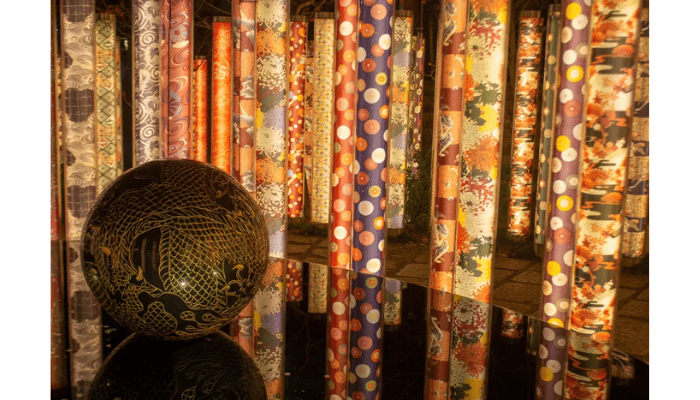
Within the station, you’ll also find the Dragon of Atago Pond, a sacred spot inspired by nearby Tenryu-ji Temple. Fed by the pure spring water from Mount Atago, the pond is believed to grant wishes.
Legend has it that praying to the dragon depicted on the sphere brings hope, and dipping your hands into the spring water brings happiness. Couples often share this experience, wishing for their happiness to last forever.
Kimono Forest
- Address: 20-2 Saga Tenryuji Tsukurimichi-cho, Ukyo Ward, Kyoto City, Kyoto Prefecture
- Map: Google Maps
- Access: Located inside Arashiyama Station on the Randen line
- Official Website: Arashiyama Hannari Hokkori Square
6. Toei Kyoto Studio Park

Opened in 1975, Toei Kyoto Studio Park (Toei Uzumasa Eigamura) is a unique theme park located at the birthplace of Japanese cinema. Many locals in Kyoto fondly remember visiting the park as children during school trips or family outings.
While it’s often seen as a family destination, this park is also a surprisingly fun and romantic spot for couples!

Step into the world of samurai dramas and enjoy action-packed live shows at real filming sets used for period dramas. Watch thrilling sword fights, join guided tours led by professional actors, and immerse yourself in ninja performances and trick art exhibits.
For those seeking a spine-chilling experience, the park features Japan’s “scariest haunted house.” It’s not just about sightseeing—there are plenty of interactive attractions to enjoy together!
Throughout the park, you’ll find humorous photo boards where you can pose as historical figures, like a villainous magistrate or the cast of Mito Komon. Snap some funny photos with your partner and create lasting memories!

One of the most popular activities here is period drama cosplay. Even if you’re not a fan of samurai dramas, you might find yourself falling in love with the experience of dressing up.
For a simple cosplay, you can rent costumes and walk around the Edo-style streets. Choose from characters like town girls, merchants, samurai, lords, or even oiran courtesans and ninjas!
Want a more authentic transformation? Opt for a full package that includes costume rental, makeup, and traditional hairstyling. It’s a unique way to enjoy the park and step back in time.
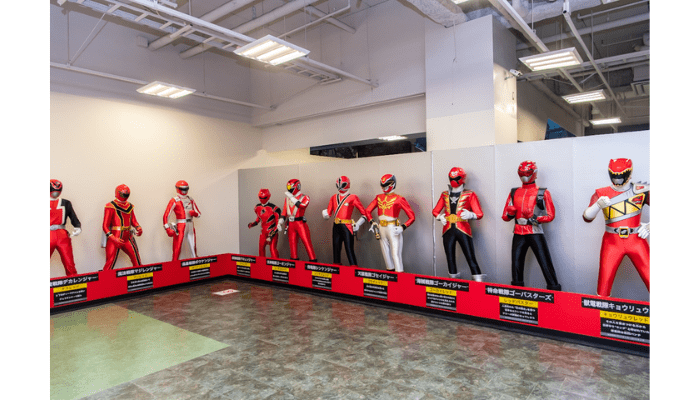
Relive your childhood by watching character shows, or challenge yourself with attractions like the Karakuri Ninja Mansion, a puzzle-filled escape room created in collaboration with a real mystery-solving game.
Whether you’re wandering through the Edo streets in costume or trying out the exciting attractions, Toei Kyoto Studio Park is a place where you and your partner can unleash your inner child and have a blast!
Toei Kyoto Studio Park
- Address: 10 Uzumasa Higashi Hachioka-cho, Ukyo Ward, Kyoto City, Kyoto Prefecture
- Map: Google Maps
- Access:
- 5-minute walk from JR Uzumasa Station
- 5-minute walk from Randen Uzumasa-Koryuji Station
- 2-minute walk from Randen Satsueisho-mae Station
- 2-minute walk from the Uzumasa Kaido Bus Stop
- Phone: 0570-064349
- Hours: 9:00 AM – 5:00 PM (Varies by season, check the official website for details)
- Admission:
- Adults: 2,400 yen
- Middle/High School Students: 1,400 yen
- Children (Ages 3+): 1,200 yen
- Official Website: Toei Kyoto Studio Park
Recommended restaurant in Western Kyoto: Sagano
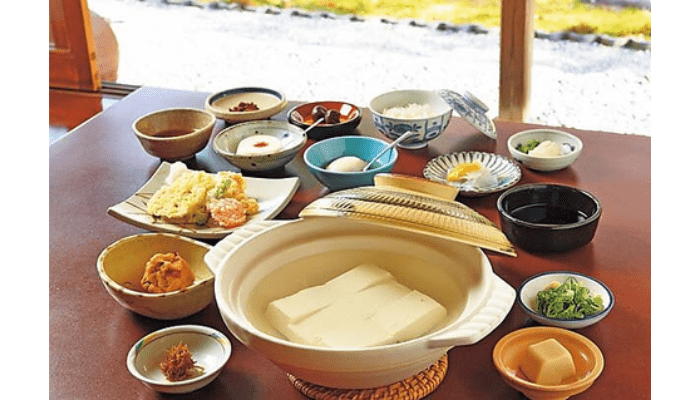
Located in the scenic Arashiyama area, Sagano is a renowned restaurant where you can enjoy delicious yudofu (hot tofu) dishes while gazing at a beautiful Japanese garden.
The highlight of Sagano’s menu is the Yudofu Gozen, a set meal featuring their signature yudofu.
The tofu is simmered in a delicate kombu-based broth, resulting in a dish with rich umami flavors that are both light and satisfying. The smooth, silky texture and gentle taste make it a truly exceptional experience you won’t find anywhere else!
In addition to the yudofu, the set meal also includes sashimi and tempura, offering a variety of flavors to enjoy.
Sagano
- Address: 45 Sagatenryuji Susukinobabacho, Ukyo Ward, Kyoto City, Kyoto Prefecture
- Map: Google Maps
- Access:
- 12-minute walk from JR Saga-Arashiyama Station
- 5-minute walk from Randen Arashiyama Station
- Phone: 075-871-6946
- Hours: 11:00 AM – 7:00 PM
- Closed:
- 4th Wednesday and Thursday in July
- December 30, 31, and January 1 (5 days total)
- Reservations: Not available
- Price Range: ¥3,000 – ¥3,999
Recommended Date Spots in Eastern Kyoto (Higashiyama & Gion)

The Higashiyama and Gion areas are at the heart of Kyoto’s rich cultural heritage, offering a vibrant mix of traditional Japanese charm and iconic landmarks.
This area is home to some of Kyoto’s most famous attractions, including Kamo River, Kiyomizu-dera Temple, and Yasaka Shrine, making it one of Japan’s top tourist destinations. It’s a lively spot, bustling with visitors on both weekdays and weekends.

Every July, the Gion Festival, one of Japan’s three major festivals, takes place here. With a history of over 1,100 years, this grand event showcases Kyoto’s traditions and energy through stunning floats and performances. Every year, tourists from across Japan and abroad gather to witness this spectacular festival up close.
The area also features elegant, quintessential Kyoto sights such as the picturesque Hanamikoji Street and the serene Kamo River views. These are perfect spots to soak in the beauty of Kyoto’s traditions and create memorable moments.
If you’re planning a romantic kimono date, Higashiyama and Gion are ideal. The area is filled with kimono rental shops and dressing services, making it easy to enjoy strolling through Kyoto’s historic streets in traditional attire.
1. Jishu Shrine

Located right next to the main hall of Kiyomizu-dera Temple, one of Kyoto’s most iconic landmarks, Jishu Shrine is a must-visit for anyone seeking blessings for love and relationships.
This shrine is dedicated to the god of matchmaking, attracting couples and those hoping for romantic success from all over Japan. Among the many Jishu Shrines across the country, this one is the most famous.
The name “Jishu” reflects the shrine’s origins as a deity worshipped as the guardian of Kyoto’s land. Today, it is known as one of the top matchmaking shrines in Japan. Many visitors carry the shrine’s popular love amulets, believing in their powerful blessings.
At Jishu Shrine, daily prayers are offered to help visitors’ romantic wishes come true.
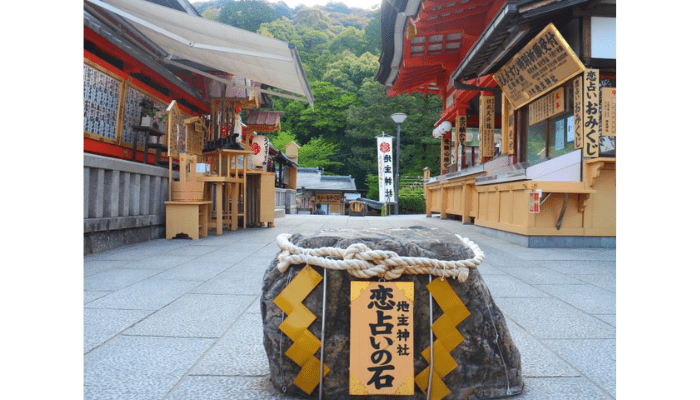
One of the shrine’s unique features is the Love Fortune Stones—two stones placed about 10 meters apart.
Here’s how it works:
- Close your eyes and walk from one stone to the other while focusing on the person you love. If you can successfully reach the second stone, your love wish will be granted!
- If you receive help from others to guide you, it means your love will succeed with the support of those around you.
Visitors from across the country share stories of how their romantic wishes came true after visiting the shrine, making it a beloved spot for love blessings.
Jishu Shrine
- Address: 1-317 Kiyomizu, Higashiyama-ku, Kyoto
- Map: Google Map
- Access:
- From Kyoto Station: Take City Bus 86, 206, or 100 to Gojo-zaka bus stop.
- From Gion-Shijo Station or Kawaramachi Station: Take City Bus 207 to Kiyomizu-michi bus stop.
- Hours: 9:00 AM – 5:00 PM (Open year-round)
- Admission: Free
- Website: Jishu Shrine Official Website
2. Maruyama Park

Maruyama Park, located just behind Yasaka Shrine, is famous for its stunning weeping cherry tree (shidare-zakura), which becomes the star attraction in spring. During cherry blossom season, the park is filled with visitors enjoying the beauty of the blooms.
While the cherry blossoms are the highlight, the park is home to a variety of flowering trees and plants. Outside of the busy sakura and autumn foliage seasons, it’s a calm and relaxing spot where you can enjoy a leisurely stroll.

Maruyama Park isn’t just any ordinary park—it’s Kyoto. The landscaping, tree placement, and overall design reflect the city’s dedication to aesthetics, giving it the feel of a traditional Japanese garden.
On sunny days, you can sit on a bench, enjoy soft-serve ice cream or traditional dango (sweet rice dumplings), and soak in the peaceful atmosphere. It’s a great spot for a casual yet memorable date.
Maruyama Park
- Address: Maruyama-cho, Higashiyama-ku, Kyoto
- Map: Google Map
- Access:
- 12-minute walk from Gion-Shijo Station (Keihan Railway)
- 13-minute walk from Kawaramachi Station (Hankyu Railway)
- 15-minute walk from Sanjo Keihan Station (Kyoto Subway)
- Hours: Open 24 hours (Spring light-up: Sunset–10:00 PM)
- Admission: Free
- Contact: 075-561-1350 (Kyoto City Greenery Association)
- Website: Maruyama Park Official Website
3. Camellia Tea Ceremony
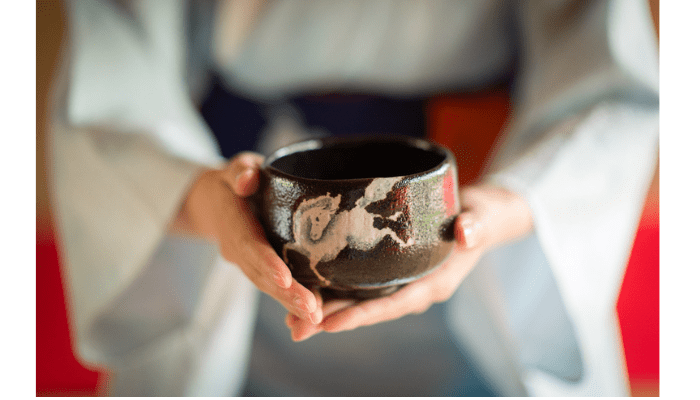
Located between Yasaka Shrine and Kiyomizu-dera, Camellia Tea Ceremony offers a unique opportunity to experience the traditional Japanese tea ceremony. Recommended on TripAdvisor, it’s popular among international visitors, but locals also enjoy it as a casual way to engage with Japanese culture.
Even though the tea ceremony is an integral part of Japanese culture, many people don’t get the chance to try it. This is your chance to learn and experience it firsthand in a relaxed and welcoming atmosphere.
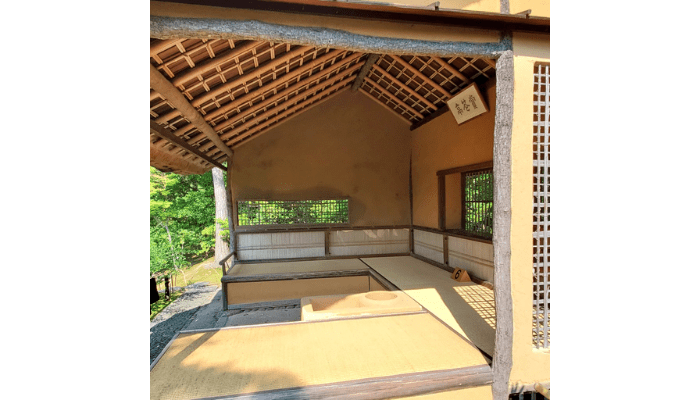
You’ll discover the profound philosophy behind the tea ceremony, which might completely change how you see this traditional art. While learning the graceful steps of tea preparation (temae), you’ll also gain insights into Japan’s rich traditions and refined sense of beauty.
Despite the tea ceremony’s serene and meditative atmosphere, the experience at Camellia is known for being approachable and enjoyable, making it perfect for beginners.
At the end, you can savor the tea you’ve made yourself, accompanied by a traditional Japanese sweet. Whether you go with a friend or partner, this shared experience is sure to bring you closer.
Camellia Tea Ceremony
- Address: 349-12 Masuya-cho, Kodaiji, Higashiyama-ku, Kyoto
- Map: Google Map
- Access: 5-minute walk from the Kiyomizu-michi Bus Stop
- Hours: 10:00 AM–6:00 PM
- Admission:
- Adults: ¥2,000
- Children: ¥1,000
- Kimono Rental + Tea Ceremony: ¥5,000
- Reservations:
- Walk-ins welcome
- For reservations, contact via email or phone
- Contact: 075-525-3238
- Website: Camellia Tea Ceremony Official Website
4. Nanzen-ji Temple

Located at the end of the Philosopher’s Path, which begins at Ginkaku-ji (Silver Pavilion), Nanzen-ji Temple is the head temple of the Rinzai sect’s Nanzen-ji school.
Originally founded in 1291 during the late Kamakura period, the temple has been rebuilt multiple times due to fires. While most of the original structures no longer exist, Nanzen-ji remains one of Kyoto’s most prestigious temples.
In the Muromachi period, under the rule of Shogun Ashikaga Yoshimitsu, Nanzen-ji was granted the highest rank among Kyoto’s and Kamakura’s Zen temples, designated as “Five Mountains Supreme” (Gozan no Ue), an honor that placed it in a class of its own.
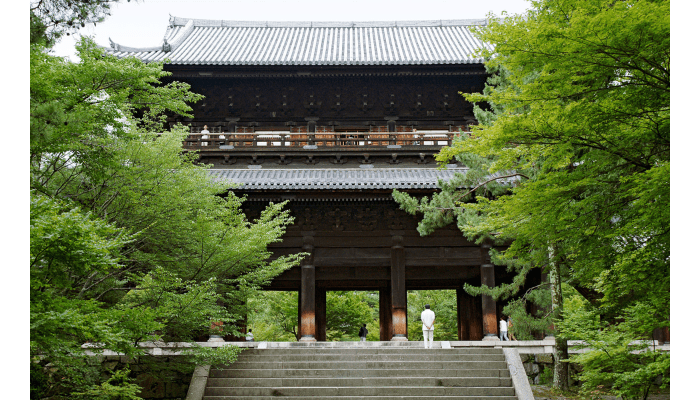
One of Japan’s Three Great Temple Gates, Sanmon Gate is famous for its connection to the legendary thief Ishikawa Goemon, who admired the “magnificent view” from this spot. Visitors can climb the gate (for a fee) to enjoy panoramic views of Kyoto from 22 meters above the ground.
Nanzen-ji boasts several stunning gardens, each reflecting different styles from various periods:
- Tenju-an Garden: Features two styles—an Edo-period dry landscape garden in the east and a pond-style strolling garden from the Nanboku-cho period.
- Hojo Garden: Known for its “Tiger Cub Crossing the River” design, a symbolic Zen garden surrounding the main hall.
- Small Hojo Garden: A modern garden created in the Showa era.
- Konchi-in Garden: A serene Edo-period garden, perfect for quiet reflection.
Each garden offers a unique atmosphere, making them perfect spots for relaxation and photography.
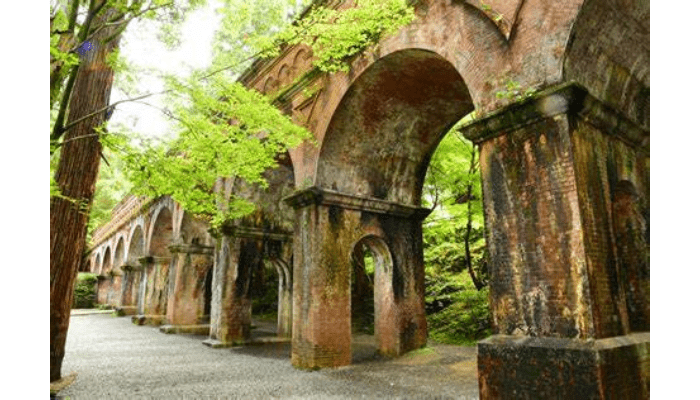
One of the most iconic and photogenic features of Nanzen-ji is the Suirokaku Aqueduct, a red brick waterway built in 1888 as part of the Biwa Canal project. This aqueduct, with its retro Western-style design, contrasts beautifully with the temple’s traditional Zen architecture, creating a unique and enchanting atmosphere.

A visit to Nanzen-ji isn’t complete without trying yudofu, a local specialty. Many restaurants near the temple serve this simple yet elegant dish, often in serene settings overlooking traditional gardens. Treat yourself to a luxurious meal or enjoy a more affordable lunch option
Nanzen-ji
- Address: Nanzenji Fukuchi-cho, Sakyo-ku, Kyoto
- Map: Google Map
- Access:
- 10-minute walk from Keage Station (Subway Tozai Line)
- 10-minute walk from Higashi Tenno-cho or Nanzen-ji Eikando-michi bus stops
- Hours:
- 8:40 AM–5:00 PM (until 4:30 PM from December to February)
- Last entry: 20 minutes before closing
- Admission Fees:
- Hojo Garden: Adults ¥600, High School Students ¥500, Children ¥400
- Sanmon Gate: Adults ¥600, High School Students ¥500, Children ¥400
- Nanzen-in: Adults ¥400, High School Students ¥350, Children ¥250
- Night Viewing: Adults ¥600, Children ¥300
- Closed: December 28–31
- Phone: 075-771-0365
- Website: Nanzen-ji Temple Official Website
Recommended Restaurant in Eastern Kyoto: AWOMB Nishikiyamachi
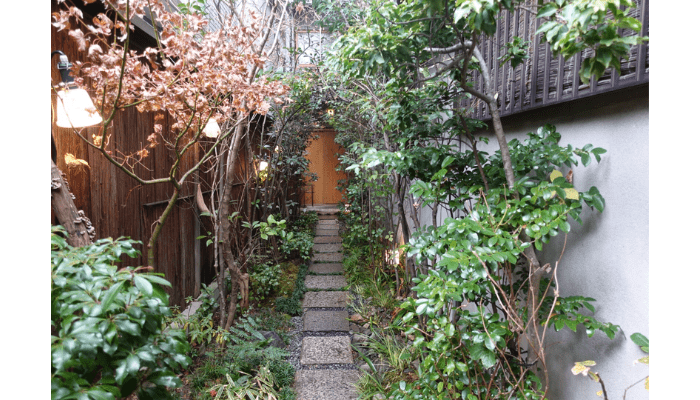
If you’re looking for colorful, cute, and photogenic temari sushi, AWOMB Nishikiyamachi is a must-visit restaurant.
The beautifully crafted sushi balls are so visually stunning that they look picture-perfect even without any filters.
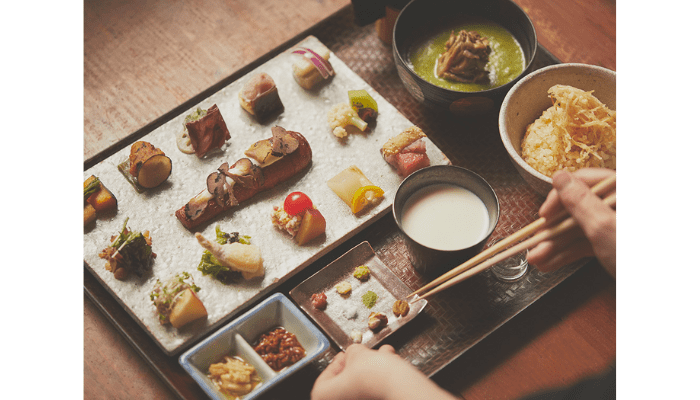
But AWOMB isn’t just about the looks—the taste is just as impressive. Each piece of sushi features a unique topping, allowing you to enjoy a variety of flavors in one meal. This makes the dining experience both exciting and satisfying, with every bite offering something new.
At AWOMB, you’ll feel the joy twice: first when the dishes are presented and then again as you savor each piece.
Since the restaurant is incredibly popular and operates on a reservation-only basis, be sure to book your spot well in advance.
AWOMB Nishikiyamachi
- Address: 405 Namba-cho, Shimogyo-ku, Kyoto, Japan
- Map: Google Maps
- Access: A 3-minute walk from the Kawaramachi Matsubara bus stop
- Phone: 075-203-5277
- Closed: Irregular holidays
- Hours:
- Lunch: 12:00 PM–2:00 PM
- Dinner: 6:00 PM–8:00 PM
- Price: ¥3,000–¥3,999 for both lunch and dinner
- Note: Reservation is required
Recommended Date Spots in Southern Kyoto (Kyoto Station and Fushimi)
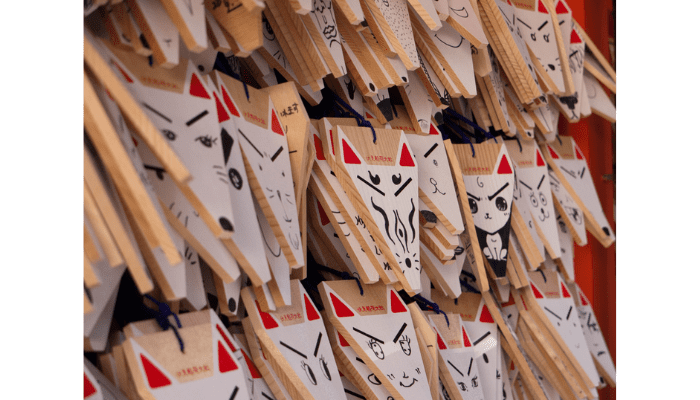
The area around Kyoto Station, a major transportation hub for the Shinkansen, JR lines, and Kintetsu Line, is full of attractions. You’ll find iconic landmarks like Kyoto Tower, Toji Temple, Nishi Honganji, and Higashi Honganji.
In Fushimi, you can enjoy a different side of Kyoto with its famous Fushimi Inari Taisha Shrine and many historic sake breweries. This area is perfect for those who want to explore both traditional temples and shrines as well as modern attractions.
1. Fushimi Inari Taisha Shrine

Fushimi Inari Taisha is the head shrine of over 30,000 Inari shrines across Japan. Built more than 1,300 years ago, it is steeped in history and continues to be a beloved place of worship.
The shrine is world-famous for its Senbon Torii (Thousand Torii Gates), a popular photo spot often seen on social media. Despite its name, the number of torii gates is actually closer to 10,000! These gates are donated by worshippers whose wishes have come true, symbolizing the shrine’s reputation for granting blessings.
The torii gates continue to grow in number, making this a truly unique and inspiring destination.

Another must-try experience is the Omokaru Ishi (the “Heavy or Light Stone”). Located on top of a lantern, this stone is said to feel heavy or light depending on your wish. After making a wish, lift the stone—if it feels lighter than expected, your wish may come true. If it feels heavier, it might take more time or effort. It’s a fun and suspenseful way to engage with the shrine’s traditions!
Fushimi Inari Taisha Shrine
- Address: 68 Fukakusa Yabunouchicho, Fushimi Ward, Kyoto, Japan
- Map: Google Maps
- Access:
- JR Nara Line: A short walk from Inari Station
- Keihan Main Line: A 5-minute walk from Fushimi Inari Station
- Phone: 075-641-7331
- Visiting Hours:
- General Worship: Open 24/7
- Prayer Services: 8:30 AM–4:30 PM (reception until around 4:00 PM)
- Amulets and Charms: 8:00 AM–5:30 PM
- Admission: Free
- Official Website: Fushimi Inari Taisha
2. Fushimi Sake Brewery Tour

Fushimi is not only home to Fushimi Inari Taisha but also renowned as a sake brewing district.
This area boasts over 20 sake breweries, including famous names like Kizakura and Gekkeikan, which many people may recognize. In addition to breweries, there are also museums where you can learn about the history of sake.
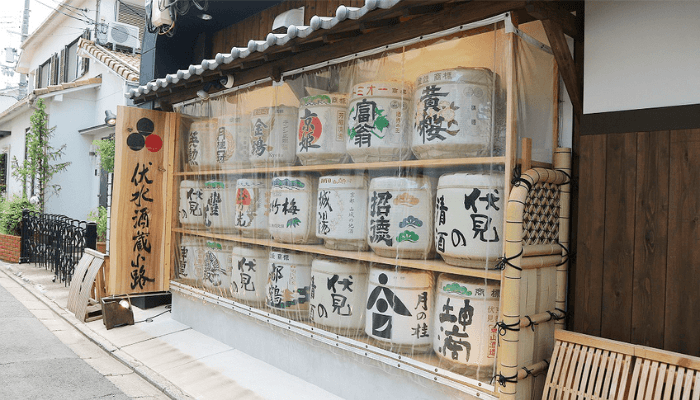
Many breweries offer tastings, making it a perfect outing for couples who love sake. Tasting sake while learning about how it’s made adds a whole new depth to the experience.
Take the time to visit different breweries and enjoy the unique flavors each one offers. However, please drink responsibly!
Fushimi Sake Brewery Tour (Fushimi Sake Brewers Association)
- Address: 318 Nishiootecho, Fushimi Ward, Kyoto, Japan
- Map: Google Maps
- Phone: 075-611-4115 (Weekdays 9:00 AM–5:00 PM)
- Note: Information may vary by brewery. Please contact the Fushimi Sake Brewers Association for details.
3. Shoju-in Temple
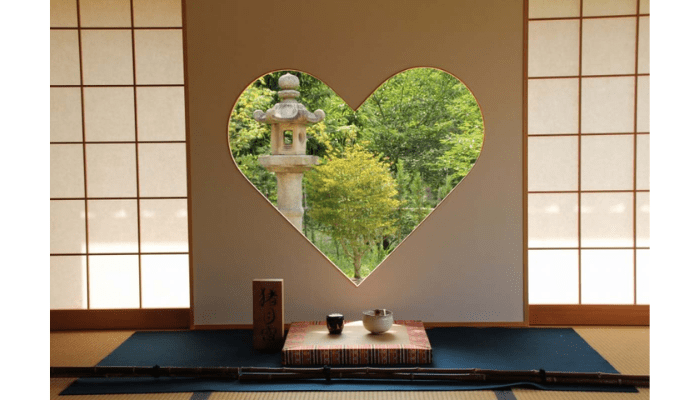
Shoju-in Temple, a Shingon Buddhist temple of the Koyasan school, was founded around 800 years ago.
Located about an hour from Keihan Uji Station by bus (or 1.5 hours from Kyoto Station), it’s a bit off the beaten path. However, this hidden gem has gained popularity in recent years, especially among women.
The temple’s main attraction is its heart-shaped window in the guest hall. While it looks modern and cute, the design is rooted in tradition. Called “Inome” in Japanese, this heart shape is a traditional pattern dating back over 1,400 years. It has been used in temples and shrines to ward off evil and bring good fortune.
The window offers a stunning view that changes with the seasons—pink cherry blossoms in spring, lush greenery in summer, vibrant autumn leaves, and serene snow in winter. It’s no wonder this picturesque spot is a favorite for photos on social media!
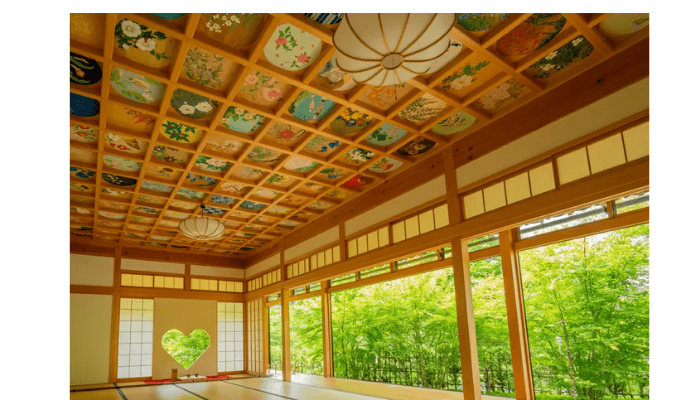
Don’t miss the ceiling in the guest hall. It features 160 stunning paintings created by Japanese artists, inspired by Japan’s landscapes and flowers. This is a modern revival of ceiling paintings originally created 300 years ago in the temple’s main hall.
Hidden among the paintings are four illustrations of maiko (apprentice geisha). Try to spot them while you admire the artwork!
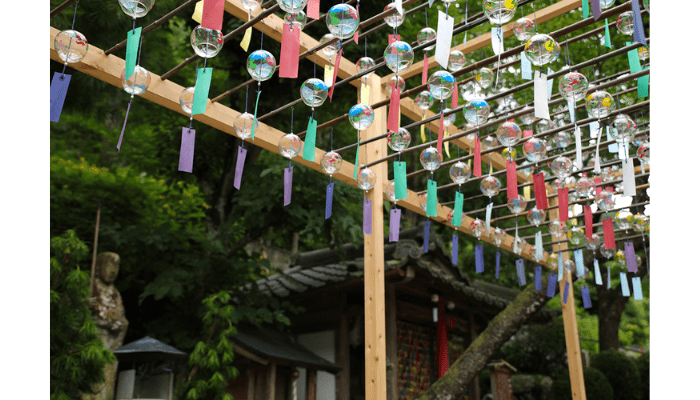
From July 1 to September 18 each year, Shoju-in holds a Furin Matsuri (Wind Chime Festival). Over 2,000 wind chimes decorate the temple grounds, including unique chimes representing all 47 prefectures of Japan. The sight and sound are truly enchanting.
During the festival, visitors can also enjoy painting their own wind chimes (for an additional fee), making for a memorable experience.
Shoju-in Temple
- Address: 149 Okuyamada Kawakami, Ujitawara, Tsuzuki District, Kyoto
- Map: Google Maps
- Access:
- From Keihan Uji Station, JR Uji Station, or Kintetsu Shin-Tanabe Station, take a Keihan Uji Bus (routes 180, 182, or 184) to Ichu-mae stop, then transfer to a community bus to Okuyamada stop, and walk 10 minutes.
- During certain periods, the Uji-cha Bus operated by Keihan Kyoto Bus runs directly to the temple entrance. Check their official website for details.
- Phone: 0774-88-3601
- Hours: 8:30 AM–4:30 PM (closes at 4:00 PM from November to March)
- Admission: ¥500 (includes tea, sweets, a decorative paper, and a wish cord)
- Official Website: Shoju-in Temple
4. Kyoto Aquarium

Kyoto Aquarium is conveniently located just a 15-minute walk from Kyoto Station.
Though it’s a relatively small aquarium, it’s a popular destination where visitors can enjoy adorable animal shows, such as dolphin and penguin performances, up close.

One of the main attractions here is the Japanese giant salamander, a species designated as a natural monument. This rare opportunity to see such a fascinating creature makes the visit even more special—don’t miss it!
Kyoto Aquarium
- Address: 35-1 Kankiji-cho, Shimogyo-ku, Kyoto (inside Umekoji Park)
- Map: Google Maps
- Access:
- From Kyoto Station, it’s a 20-minute walk.
- By bus, take Kyoto City Bus routes 205, 208, 103, 104, or 110 and get off at Shichijo-Omiya/Kyoto Aquarium Mae. The aquarium is a 3-minute walk from the bus stop.
- Phone: 075-354-3130
- Hours:
- Check the official website for the annual calendar of operating hours.
- Special nighttime hours may apply on certain days.
- Last admission and ticket sales are available up to one hour before closing.
- Hours may change due to weather or maintenance.
- Admission:
- Adults (including university students): ¥2,200
- High school students: ¥1,700
- Elementary and junior high school students: ¥1,100
- Children (age 3 and older): ¥700
- Official Website: Kyoto Aquarium
5. Daigo-ji Temple

Daigo-ji Temple, a UNESCO World Heritage Site, is famous for the luxurious “Hanami at Daigo” cherry blossom viewing event hosted by Toyotomi Hideyoshi.
Starting with early-blooming Kawazu cherry blossoms around the spring equinox, the temple showcases a stunning variety of cherry trees, including weeping cherry blossoms, Somei Yoshino, wild mountain cherries, double-flowered cherries, crimson weeping cherries, and Oyama cherries. Over 1,000 cherry trees bloom in a mesmerizing display that lasts about three weeks.
Among the highlights are:
- The cherry blossom tunnel at the temple’s entrance.
- The magnificent weeping cherry tree in front of the Reihokan Museum.
The best time to see these is typically the first week of April.

Temple Highlights and Cultural Treasures
- While the temple grounds are free to enter, tickets are required to visit the Reihokan Museum, Sambō-in, and the Garan.
- The Reihokan Museum houses an impressive collection of around 100,000 artifacts, including national treasures and important cultural properties.
- The Sambō-in features stunning sliding screen paintings by Kano Sanraku and a strolling garden specially designed by Toyotomi Hideyoshi.
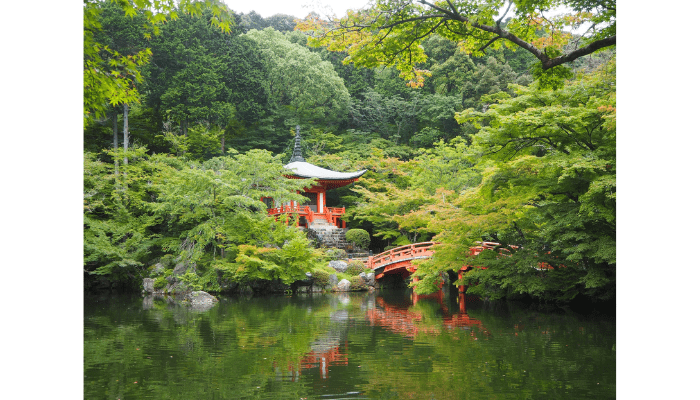
Surrounded by a dense forest, Daigo-ji is home to 80 species of wild birds, making it a peaceful retreat for nature lovers.
While the cherry blossom season is particularly popular, the temple also offers breathtaking views in summer with lush greenery and vibrant autumn leaves. It’s a perfect destination for couples looking to enjoy both history and natural beauty.
Daigo-ji Temple
- Address: 22 Higashi-Oji-cho, Daigo, Fushimi-ku, Kyoto
- Map: Google Maps
- Access: A 15-minute walk from Daigo Station on the Kyoto Metro Tozai Line
- Phone: 075-571-0002
- Hours:
- Sambō-in, Reihokan Museum, and Garan: 9:00 AM – 5:00 PM (last admission at 4:00 PM)
- From the first Monday in December to the end of February: Closes at 4:30 PM (last admission at 3:30 PM).
- Kami Daigo (Upper Daigo): 9:00 AM – 4:00 PM (must descend by 5:00 PM)
- From the first Monday in December to the end of February: Closes at 3:00 PM (must descend by 4:00 PM).
- Sambō-in, Reihokan Museum, and Garan: 9:00 AM – 5:00 PM (last admission at 4:00 PM)
- Admission Fees:
- Adults: ¥1,000 (¥1,500 during spring)
- Middle and high school students: ¥700 (¥1,000 during spring).
- Official Website: Daigo-ji Temple
6. Kyoto Tower

Standing tall in front of JR Kyoto Station, Kyoto Tower has been a beloved symbol of the city since its opening in 1964.
At 131 meters tall, it is the tallest building in Kyoto, with its observation deck located 100 meters above the ground.
End your day in Kyoto with a visit to Kyoto Tower’s observation deck. From here, you can enjoy a 360-degree panoramic view of the city. On clear days, you might even catch a glimpse of Osaka in the distance.
Unique to Kyoto, you can spot iconic World Heritage Sites like Kiyomizu-dera and Nishi Honganji from above. The sheer number of temples and shrines visible may surprise you!

To celebrate the tower’s 50th anniversary, a small shrine called Tawawa Shrine was added to the observation deck. Its deity is “Tawawa-chan,” the tower’s cute mascot. The golden Tawawa-chan resembles Osaka’s famous Billiken statue and is said to bring good fortune and connections.
You can even write your wishes on a Tawawa-chan ema (wooden plaque), which will be blessed at Shimogamo Shrine, a significant Kyoto landmark.
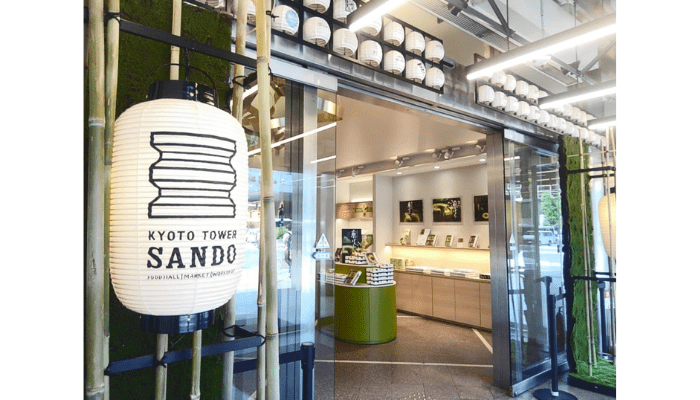
The basement to the second floor of Kyoto Tower houses “KYOTO TOWER SANDO,” a shopping and dining facility revamped in April 2017.
- B1 Floor Food Hall: A variety of delicious food options await you.
- 1st Floor Souvenir Shops: The stylish design will impress even long-time visitors.
- 2nd Floor Experiences: Try fun activities like making yatsuhashi (Kyoto’s famous sweet), learning sushi-making techniques, or painting pottery produced by a Kiyomizu ware workshop. These are perfect for couples or anyone looking for a hands-on Kyoto experience.

For the ultimate romantic gesture, why not propose at Kyoto Tower? After hours, from 9:30 PM to 10:00 PM, you can rent out the observation deck for a private proposal.
- Available for one couple per day.
- Monday to Thursday: ¥20,000
- Friday to Sunday, holidays: ¥30,000
- Optional extras include flowers, gifts, and dinner.
Reservations must be made at least two weeks in advance. Contact Kyoto Tower directly for details.
Kyoto Tower Information
- Address: 721-1 Higashi Shiokoji-cho, Karasuma-dori, Shichijo-sagaru, Shimogyo-ku, Kyoto
- Map: Google Map
- Access: 2-minute walk from JR Kyoto Station
- Phone: 075-361-3215
- Hours: 10:30 AM – 9:00 PM (Last entry: 8:30 PM)
- Admission:
- Adults ¥800
- High school students ¥650
- Elementary/Middle school students ¥550
- Children (3+ years) ¥150
- Website: Kyoto Tower Official Website
Recommended Restaurant in Southern Kyoto: Nakamura Tokichi
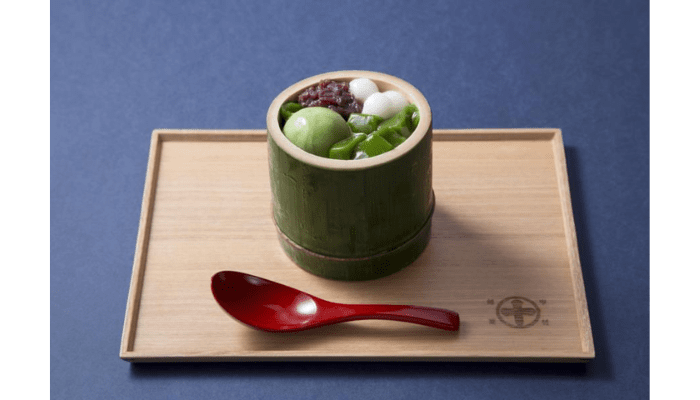
Nakamura Tokichi is a traditional tea shop that offers a café experience where you can indulge in exquisite matcha sweets crafted by expert tea artisans.
The menu, created by those who truly understand the art of matcha, has captivated countless visitors. It’s so popular that you’ll often see a line, even on weekdays!
Prepare to be amazed by the rich, deep flavors of matcha that you’ve likely never tasted before. The desserts are a perfect blend of tradition and innovation, offering an unforgettable matcha experience. Don’t miss the chance to enjoy these exceptional matcha sweets made by one of Kyoto’s finest tea shops.
Nakamura Tokichi Main Store – Kyoto Station Branch
- Address: JR Kyoto Isetan, 3F, Higashi Shiokoji-cho, Shimogyo-ku, Kyoto, Japan
- Map: Google Map
- Access: Located inside JR Kyoto Station, just a short walk away.
- Phone: 075-342-2303
- Hours: 11:00 AM – 10:00 PM (Last order: 9:00 PM)
- Budget: Lunch/Dinner ~¥999
- Closed: Open year-round
The Charm of a Kimono Date in Kyoto and Tips to Enjoy It
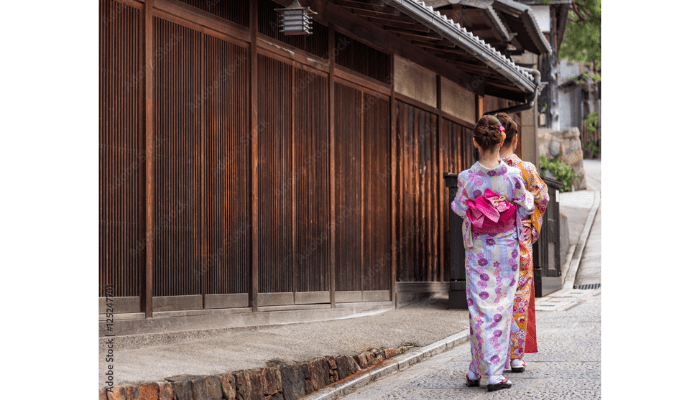
A kimono date in Kyoto is a dream for many, and it’s easy to see why. As you stroll through the historic streets, you’ll often spot couples dressed in elegant kimonos, adding a touch of timeless beauty to the cityscape.
Wearing a kimono creates a unique atmosphere, making you and your partner see each other in a fresh, enchanting way. Women exude grace and elegance, while men appear poised and refined. It’s a wonderful way to create special memories together.
When it comes to taking photos in Kyoto’s picturesque streets or at historical landmarks, nothing beats the charm of a kimono. The vibrant patterns and traditional look blend seamlessly with Kyoto’s scenery, making your pictures stand out even more.
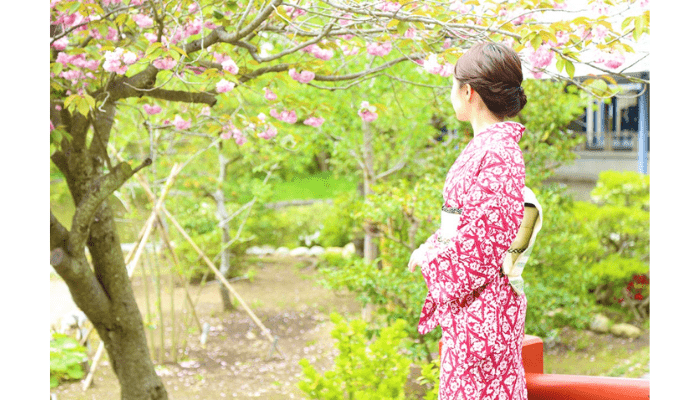
Things to Keep in Mind for a Kimono Date
While a kimono date is full of charm, there are a few things to watch out for to ensure your experience is enjoyable:
- Comfortable Walking
Kimono dates often involve wearing zori (traditional sandals), which may feel uncomfortable if you’re not used to them. Walking long distances can cause foot pain, so it’s best to plan a route with shorter walking distances and fewer stairs. Bringing some band-aids can be a lifesaver! - Dining in a Kimono
Kimonos are tied snugly with multiple layers of sashes and cords, leaving little room to move. After a meal, the tight fit around your stomach can feel quite restrictive. To avoid discomfort, consider opting for a light meal during your outing.
By keeping these tips in mind, you can enjoy your kimono date to the fullest!
Why not try it for yourself and make beautiful memories in Kyoto?
This time, we’ve handpicked some of the best spots in Kyoto for a romantic date.
From temples and shrines known for their blessings in love to serene places where you can relax and enjoy Kyoto’s beautiful scenery, there’s something for every couple to enjoy.
Take a look at the unique features of each spot, plan your route, and choose the perfect destinations for your memorable day together!
▼ Related Articles for Kyoto Sightseeing

